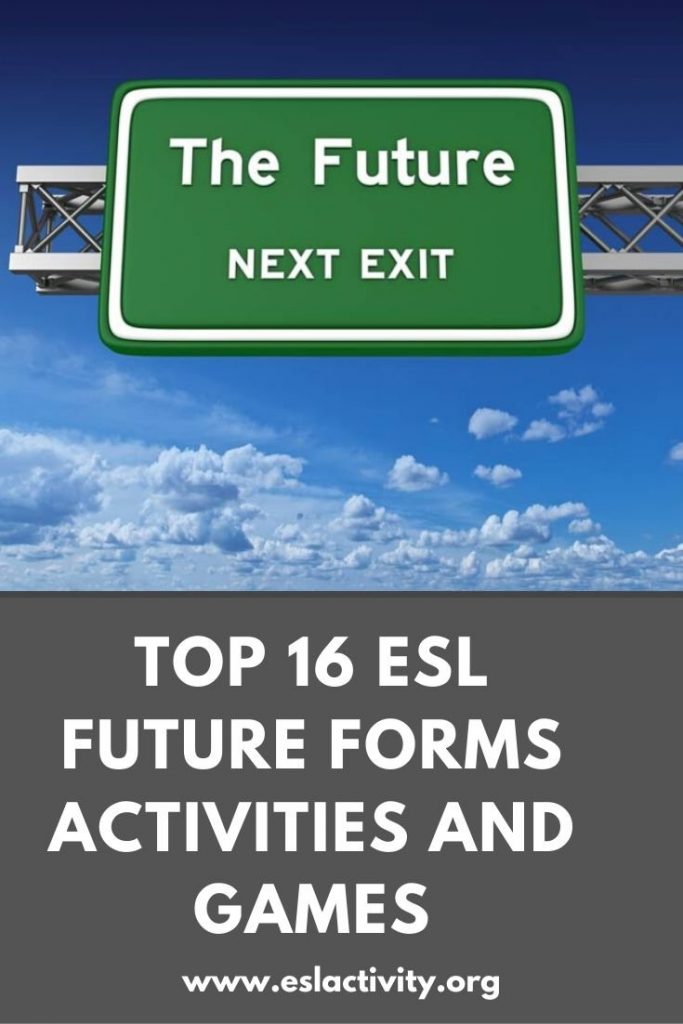Are you looking for some future forms games, worksheets, activities, lesson plans and online practice? Then you’re in the right place! We’re going to give you a rundown on the top “will” and “going to” activities you can try out with your ESL/EFL students

Future Activities for ESL
Future Activities for ESL/EFL
Let’s get to my favourite ESL activities for will, going to and other future forms. Keep on reading for all the details that you need to know!
#1: Future Tense Surveys
I’m ALL about using surveys in my English classes. They are one of the most versatile ESL activities out there and can be used for a ton of different grammar points and topics. However, they lend themselves especially well to talking about the future. The questions you include can be related to the following:
- After class plans
- Vacation plans
- After graduation
- Marriage and kids
- Etc.
Do you want to find out more about how to make your own future form surveys? Then you’ll definitely want to check this out:
#2: Just a Minute ESL Future Tense Activity
This is a fun ESL activity that gets students talking for one entire minute about a certain topic without stopping. You can turn it into a fun, interactive activity by putting students into groups of four and requiring that each student who was listening ask a follow-up question or two at the end of the minute.
The key to using Just a Minute with the future tense is choosing good topics. Check the previous future activity for some ideas.
- Amazon Kindle Edition
- Bolen, Jackie (Author)
- English (Publication Language)
- 112 Pages - 10/24/2019 (Publication Date)
#3 Future Sentences Activity: Videos
I’m ALL about using YouTube or English Central videos in my classes. You can find one on literally every single topic, vocabulary set or grammar point under the sun. But, there’s more to it than just popping the video on and chilling out.
There are so many things you can do with the, pre and post-watching. Or, you may want to mix things up and let another teacher do the heavy lifting and explain the differences between the tenses. I mean, I’m sure my students get tired of hearing me talk sometimes!
For some of my best ideas, you’ll want to check this out: ESL Videos in the Classroom.
#4: Find Someone Who Bingo
Usually I use this Bingo game as an icebreaker activity on the first day of class. However, you can very easily adapt it to make it an ideal exercises for future tenses. Instead of asking icebreaker questions related to hobbies, family, etc., you could make questions related to the future.
For example, asking about vacation plans, the next meal, after school, etc. Do you want to try it out with your students? Check it out here:
#5: Is that Sentence Correct?
If you’re working on future forms and constructing grammatically correct sentences with your students, then you’ll want to check out this activity. It’s very simple and makes an ideal review at the end of a class, or beginning on the next one.
The way it works is that you write a few sentences on the board using the future tense. Some of them will have errors that can relate to either form or meaning. Students have to work together to correct the errors.
Do you want to find out more about this simple review activity? Check it out here: ESL Correct the Sentence.
#6 Going to Activities: Dictogloss
If you want to challenge your students’ listening and writing skills, then you’ll want to consider using Dictogloss. The way it works is that you find a passage of some kind at a slightly higher level than your students are at. Then, you read it at a normal pace and students have to work together to recreate the story.
In this case, you’d want to choose something talking about the future which will likely have lots of examples of going to sprinkled throughout (or whatever other target grammar point you want). Do you want to know more about this versatile ESL activity? You can check it out here:
Dictogloss Listening and Writing ESL Activity.
#7: Listen for One Specific Thing (Future Forms)
If you do listening with your students, one really valuable thing you do is to get your students to listen for just one specific thing. In this case, it’d be examples of people talking about the future using will/going to/simple present or other future tense constructions.
The best places to find listening passage related to what you’re teaching are the textbook that you’re probably using. But, there are a ton of other sources. Find out more details here:
ESL Listening; One Specific Thing.
#8: Picture Prompt for Making Future Predictions
A fun way that you can get students using future tenses to make predictions is to find an interesting picture of some kind that lends itself well to different future possibilities. Then, students have to tell you (or a partner) what they think is going to happen.
Learn more about using pictures for various things here: Picture Prompt ESL Speaking Activity.
#9 Talking about the Future Exercises: Proof-Reading + Editing
I sometimes think that if students only practice something by speaking, it never really becomes solid and gets to the level of actually “knowing.” This is where written practice is ideal for an ESL/EFL class. And one of the ways to do is to get your students practicing some proofreading and editing.
Find a passage (or write one yourself) with lots of examples of will/going to. But, make some mistakes and use them in the wrong situations, or make the grammatical construction wrong. Then, students have to go through the worksheet and find the mistakes.
Do you want to know more about this ESL writing activity? You can check it out here: Proofreading ESL Activity.
#10: Yes/No Question Games and Activities
If you’ve taught your students about the future tense before, you’ll probably notice that there are a lot of question/answer style of activities. That’s because it’s difficult to talk about the future without talking about future plans and of course, you’ll need to have some questions for this in most cases.
If you want to see some of our top choices to help you plan for this, check this out here: ESL Yes and No Activities.
#11: ESL Listening Lesson With Future Forms
A nice way to teach students about the future tenses in English is with a listening lesson. Find a conversation between two people talking about something happening in the future. Or, somebody talking about an upcoming plan that they have (it could be you!). Then, turn it into an entire lesson using these simple steps.
#12: Conversation Starters
If you ask your students what they want to work on in your speaking or conversation classes, they’ll often say “free-talking.” This can be a little bit difficult when you just tell your students to, “Talk about the future!” It helps to give them something more concrete and specific.
That’s why I like to make some conversation starter questions that students can talk about. Some students will only make it to the first 1-2 questions, while others will make it through all 10 in the allotted time. The important thing is that students are talking in English!
I prefer to make my own questions based on the topic of the day, whether it’s vacation plans, or plans for after graduation, or anything else for that matter.
#13: Future Board Games
I LOVE to play board games in real life, so like to introduce them into my classes too. However, if you want to target a specific language concept, you’ll probably need to make your own. It’s very easy to do this with future sentences. You can write some questions on the board game like the following:
- What are you going to do this summer?
- Where are you going to eat lunch today?
Or, you may want to write some answers and students have to think of the question.
- I’m going to take an English class this summer.
- I will probably have dinner with my friend tonight.
Do you need more details about making your own games? Check this out: ESL Board Games.

Going to Exercises and Worksheets
#14: My Future Plans
In this simple activity, students write down a few of their future plans using the correct grammatical construction. I generally narrow it down to a more specific topic like weekend plans. Then, students have to give me all their papers with plans using future forms. Depending on the class size, I do one of two things.
For smaller classes, I’ll read out the papers and the entire class can guess who it is. For larger classes, I give each student one paper and they have to walk around asking questions to find out who it is.
#15: Error Correction Relay Race
#16: Plan a Holiday
One task based activity that I like to do with my students for the future tenses is to tell them that my parents are coming to visit their country for a week and that they have to plan a trip for them. Think about that—it’s all future tenses, right? Then, they have to do a short presentation in front of the class and I choose the trip that my parents will like best!
- Amazon Kindle Edition
- Bolen, Jackie (Author)
- English (Publication Language)
- 99 Pages - 06/22/2021 (Publication Date)
#17: Just One Question Survey Activity
Try out this ESL survey activity to round out your unit on future plans. The way it works is that students work in pairs to think of one interesting question related to a future plan. Then, they have to survey their classmates, compile and report the results. It’s interactive, engaging and lends itself well to using lots of future tense sentences!
Do you want to know more about it? Find out here: Just One Question ESL Survey.
#18: Discussion Starters and Conversation Topics
Check out this video on YouTube for a fun activity you can try out with your students today:
#19: Making Predictions
One very common usage of the future tense in English is to make predictions about the future. The good news is that there are so many interesting and engaging activities that can help our students practice this. More details here:
#20: Eliciting in an ESL Future Tense Lesson
Unless you teach beginners, it’s likely that most students are at least a little bit familiar with some of the ways to talk about the future in English. If this is the case, starting off the lesson with some eliciting can be very fruitful. There are two main reasons to consider doing this.
The first reason is to find out what the students already know. This makes it easier to target the rest of the lesson to what they don’t. Secondly, eliciting is ideal for helping students activate their prior knowledge they have about the future tense. This will make new things easier to remember.
Want to know more? Have a look here:
#21: Dictation ESL Future Tense Activity
Dictation has fallen out of favour a little bit these days with the more communicative approach to language teaching and learning. However, it can still be quite a valuable exercise. It’s ideal for reviewing the future tenses, as well as punctuation and listening/writing skills.
For a future tense ESL activity, I generally say either a statement or future question. Then, students have to write it down in their notebooks. If it’s a question, they have to answers it. If it’s a statement, they have to make the corresponding question.
#22: ESL Future Tense Activity Running Dictation
#23: Future Timeline
Create a timeline on the board or distribute a timeline handout to each student. Provide different events or situations that will occur in the future. Students must place the events on the timeline using the appropriate future form and discuss their placement with a partner.
#24: Fortune Teller Activity
Provide each student with a piece of paper to create a fortune teller (also known as a cootie catcher). Write different future scenarios or questions on the flaps, and the students must use the future forms to respond to the scenarios or answer the questions when they interact with the fortune teller.
#25: Future Interviews
Have students work in pairs. One student plays the role of a famous person or a character from a book or movie. The other student acts as a journalist and interviews them about their future plans or predictions. The interviewer must ask questions using different future forms, and the famous person or character responds accordingly.
#26: Future Newspaper Articles
Ask students to imagine they are reporters for a future newspaper. In pairs or small groups, students write articles about events or developments that will happen in the future. They must use the appropriate future forms to describe the events and their significance.
Future Will vs Going To: What’s the Difference Between these Future Forms?
Although when to use going to and will may seem complicated, it’s actually not! Basically, here are the rules:
- You can use either will or going to when making predictions about the future with no difference in meaning (I think it’s going to snow tonight/I think it will snow tonight).
- Will is used to express future actions decided at the moment of speaking (Who can turn off the lights? I will).
- Going to describes future plans decided before speaking (I’m going to go to the University of ABC next year).
- Will is used for a future fact (The sun will set tonight).
- Going to is useful for something that will happen right now (Hurry up! We’re going to miss the bus).
What about the Simple Present to Express the Future?
Have you noticed some sentences that use the simple present to talk about the future? Here are some examples:
- The plane takes off at 7 pm.
- The bus leaves at 2.
Notice the similarity? The present simple is used to express a future time or schedule of some kind.
FAQs
There are a number of common questions that have about teaching students how to talk about the future. Here are the answers to some of the most popular ones.
How do you introduce the future forms to ESL students?
Start by explaining the different future forms and their usage. Provide examples and practice activities to help students understand the differences between “will,” “be going to,” and the present continuous tense for future plans.
How can you practice the future forms in class?
Practice activities can include role-playing future conversations, creating future predictions or plans, completing sentences using the appropriate future form, or discussing future goals and aspirations.
How do you teach the concept of future time expressions?
Introduce common future time expressions such as “tomorrow,” “next week,” “in the future,” etc. Teach their usage and placement in sentences to indicate specific time references.
How do you address common errors when teaching the future forms?
Provide explicit instruction on common errors, such as using “will” for plans or forgetting to use the correct auxiliary verb. Offer practice activities and provide corrective feedback to help students internalize the correct usage.
How can you make teaching the future forms engaging and interactive?
Incorporate games, role plays, and group activities where students can practice using the future forms in a meaningful context. Use real-life examples and encourage discussions about future plans and predictions.
What are some strategies for teaching the future forms to beginner-level ESL students?
Simplify the language and focus on basic future forms, such as “will” for predictions or “be going to” for plans. Use visuals, gestures, and real-life objects to aid understanding and engage students in interactive activities.
How can you help ESL students understand the nuances of using different future forms?
Provide clear explanations and examples that highlight the specific contexts and meanings associated with each future form. Compare and contrast the usage to help students grasp the nuances.
How important is it to provide contextualized practice when teaching the future forms?
Contextualized practice is crucial as it allows students to apply their understanding of the future forms in realistic situations. It helps them develop fluency and confidence in using the appropriate future form based on the context.
Will and Going to Worksheets
Will vs going to exercises: here’s where you can find them! If you use an ESL textbook, you might find that there simply isn’t enough practice in this important concept. Or, if you use no books, then you’ll of course want to use some future tense worksheets to help your students solidify their knowledge. Here are some of our top recommendations:
ESL Future Tense Lesson Plans
Okay, I get it. You’re super busy and don’t have a ton of time to plan English lessons. We’ve all certainly been there. The good news is that you don’t have to reinvent the wheel! There are a ton of ready-made ESL future tenses lesson plans that you can just print and go. Here are some of the best ones out there:
Online Practice for Future Sentences
Do you want to recommend some extra practice for your students with things like going to and will? Or, the other future tenses? You can check out some of our top picks right here:
Did you Like These Games, Activities and Worksheets for Future Forms?
- Amazon Kindle Edition
- Bolen, Jackie (Author)
- English (Publication Language)
- 112 Pages - 10/24/2019 (Publication Date)
Yes? Thought so! Then the book you’re going to love is this one over on Amazon: 39 No-Prep/Low-Prep ESL Grammar Activities. If you teach English grammar, spice things up a bit in your classroom with these fun, engaging activities.
The key to students who love learning English is a wide variety of activities in your classes. This book will help you do just that and you can make it through an entire semester in style!
You can get this activity book in both digital and print formats. Take the e-version with you on your phone or tablet for lesson planning on the go. Or, keep a copy of the book in the bookshelf in your office to use as a handy reference guide. It really is that easy to have better English classes, including ones on the future tenses.
Do you want to find out more? Check out the book for yourself on Amazon, but only if you want a serious dose of ESL teaching awesome in your life:
Activities and Games for Future Forms: Join the Conversation
Did you like these will and going to exercises? Did you try out one of them from this list, or do you have another activity that you’d like to recommend to us? Leave a comment below and let us know what you think. We’d love to hear from you.
Also be sure to give this article a share on Facebook, Pinterest or Twitter. It’ll help other busy teachers, like yourself who are preparing to teach about the future tenses.
Last update on 2022-07-17 / Affiliate links / Images from Amazon Product Advertising API






